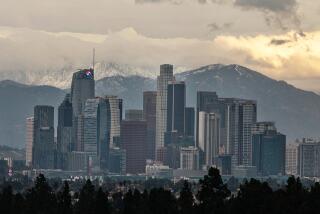Bank Woes May Put S. Korea in Second Crisis, Analysts Say
- Share via
SEOUL — Bad loans at South Korean banks are mounting so quickly that the country may plunge into a second financial crisis, analysts said.
Concern over the South Korean economy’s near-term prospects has hammered stock prices down sharply since early March, and the market tumbled 3.5% on Thursday alone.
About 3,300 companies have failed each month since South Korea turned to the International Monetary Fund in December. As a result, banks’ bad loans, which totaled $16.5 billion at the end of 1997, may more than quadruple by the end of this year, according to the Korea Development Institute, a government think tank.
With bad loans rising, the cost of rescuing banks may dwarf the $60 billion in emergency credit arranged by the IMF just four months ago, analysts said. South Korea may be forced to borrow abroad or raise taxes to foot the bill and safeguard its currency.
At the very least, soaring bad debts are likely to prolong South Korea’s first recession since 1980.
The extent of the bad loans--already 6% of all those outstanding at South Korean banks--won’t be clear until government statistics are compiled months from now.
But in a report issued Wednesday, the Korea Development Institute said the financial industry’s total bad loans may reach $72.8 billion by year’s end unless the industry is reorganized. That figure is equivalent to a quarter of the value of all the goods and services produced in the country.
The report triggered a broad decline in the stock market on Thursday, sending the main South Korean share index down 3.5% to 416.54, lowest since Jan. 9--when the index was recovering from a 10-year low of 350.68 reached on Dec. 12.
An index of bank stocks plunged 8.2% to a 12-year low Thursday.
Early today the main stock index rebounded somewhat, gaining 2% to 424.78.
South Korean banks may not be the only ones hurt by the business sector’s crash. About a fifth of the $500 billion of South Korean corporate debt outstanding is denominated in foreign currencies, and most of that was borrowed from foreign banks and bond investors.
The South Korean currency, the won, has stabilized around 1,400 to the dollar in recent weeks. It has strengthened this year from its January lows of more than 1,800 to the dollar on hopes that the IMF package would be enough to stem the economy’s slide.
South Korea also has sold $4 billion of international bonds and plans to sell billions more this year to raise badly needed capital.
Now some analysts said optimism over a quick fix may have been misplaced.
“The cost of bailing out Korea could exceed 40% of [gross domestic product],” said Desmond Supple, head of Asian currency research at Barclays Capital Ltd. “The country will lose foreign currency reserves, and the government deficit will explode.”
The South Korean government already injected $801 million each into the country’s two weakest banks, Korea First Bank and SeoulBank.
Meanwhile, Hanil Bank shares have fallen two-thirds this year, buffeted by the bank’s exposure to Hanwha Group and Kohap Group, two South Korean conglomerates, or chaebol, that have sought emergency loans.
“I don’t think those chaebol pose us any major threat,” said Chung Ki Hwa, a manager in Hanil’s planning and coordinating division.
Only a month ago, foreign creditors agreed to extend almost $22 billion of maturing South Korean bank debt for as long as three years. The rollovers helped spark a 50% stock market rally at the start of this year that has now been all but erased.
“The one-time shot of adrenaline from the bank rollover has worn off,” said James Rooney, president of Ssangyong Templeton Investment Trust Management Co., who says he won’t be looking at South Korean banks for at least 18 months. “The practices that led to the bad loans are not going away. If anything, they’re getting worse.”
Those practices include loans made with little regard for risk. Several bankers were jailed in recent years for accepting bribes for loans.
Bad loans are poised to rise because most are only counted after interest hasn’t been paid for at least six months.
That means the corporate failures so far this year have yet to show up in banks’ own figures.
What’s more, the country’s top 30 chaebol increased their bank borrowing by about 50% last year at a time when interest rates were rising. Some of those loans may not be repaid.
The cost of bailing out a country’s banking industry can be astronomical. In Mexico, for example, the cost of resolving the 1994-95 crisis is equivalent to about 14% of the country’s GDP.
Sweden’s banking crisis in the early 1990s wreaked havoc with government finances, and its bad-loans-to-GDP ratio was only about 5%, much smaller than Korea’s.
For South Korea, the nearest precedent could be Chile.
According to the IMF, the cost of bailing out Chile’s banking industry between 1981 and 1985 amounted to as much as 41% of GDP. Chile’s nonperforming loans peaked at about 16% of all loans.
This crushed Chile’s currency, the peso. It plunged to 185 to the dollar by 1985 from 39 in 1981.
* MARKET DIVES: South Korean stocks sliding toward January lows. Investor Spotlight, D8
More to Read
Sign up for Essential California
The most important California stories and recommendations in your inbox every morning.
You may occasionally receive promotional content from the Los Angeles Times.













